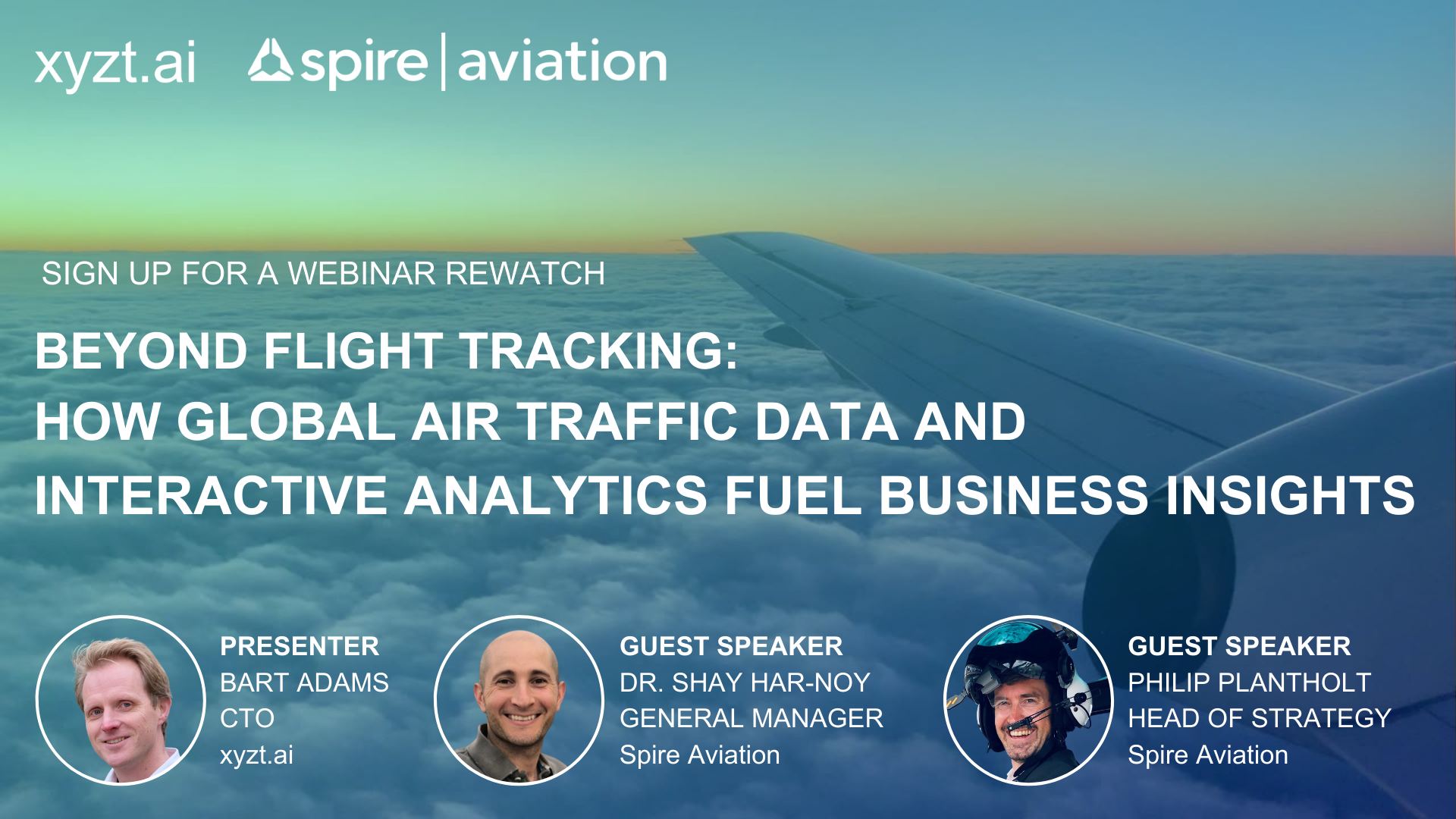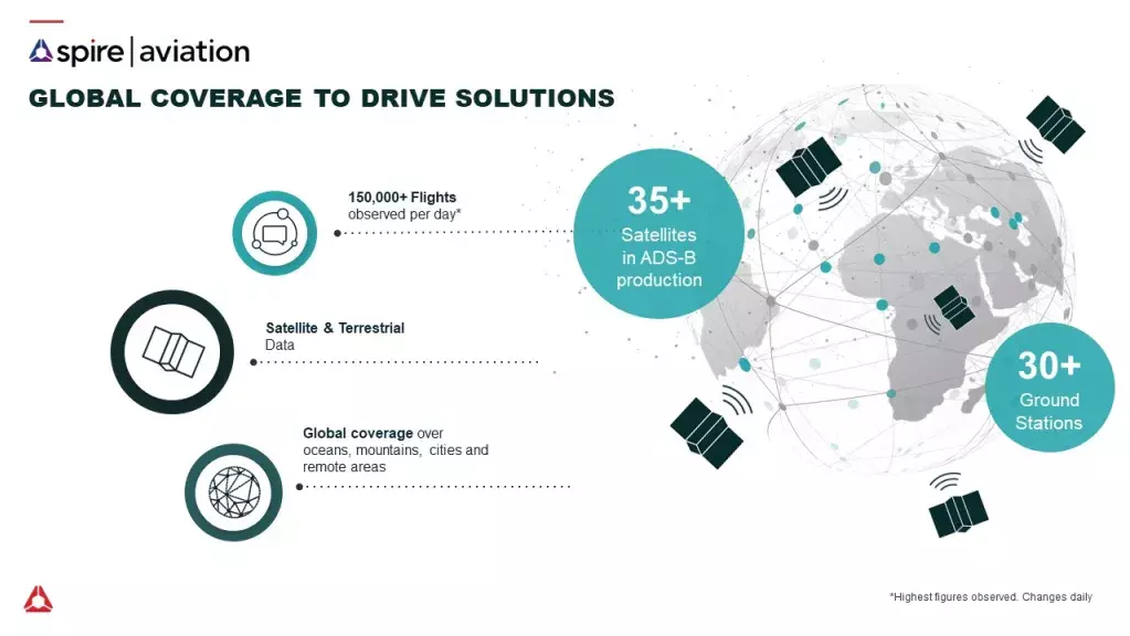In this special webinar, Dr. Bart Adams, Founder and CTO at xyzt.ai, a big location data visual analytics platform, discusses together with industry experts Dr. Shay Har-Noy, General Manager at global air traffic data provider Spire Aviation, and Philip Plantholt, Head of Strategy and Business Development at Spire Aviation, how air traffic data can be used to generate business insights and why it is also interesting for companies and organizations outside the aviation industry.
This webinar follows a different format than usual. Five hypotheses will be stated to highlight the value behind air traffic data, followed by a discussion by the industry experts.
If you would like to re-watch the webinar, you can register to view it here or continue reading to catch up on the highlights discussed during the xyzt.ai and Spire Aviation webinar.
Beyond flight tracking: the versatility of air traffic data
Global air traffic data, just as any other type of data, is only valuable if we understand what it means. Therefore, we will start with the basics and learn what kind of information air traffic data holds, where it comes from, and how we can extract value from it.
What is air traffic data?
Global air traffic data is a valuable source of aircraft and aviation activity that can be leveraged for informed decision-making and business improvements. The quality of that source depends on how global and inclusive the coverage of the data is. Dr. Shay Har-Noy, General Manager at global air traffic data provider Spire Aviation, informs us that Spire Aviation provides near-real-time tracking of aircraft using a combination of satellite and terrestrial ADS-B data that covers the global activity of more than 150,000 flights per day.
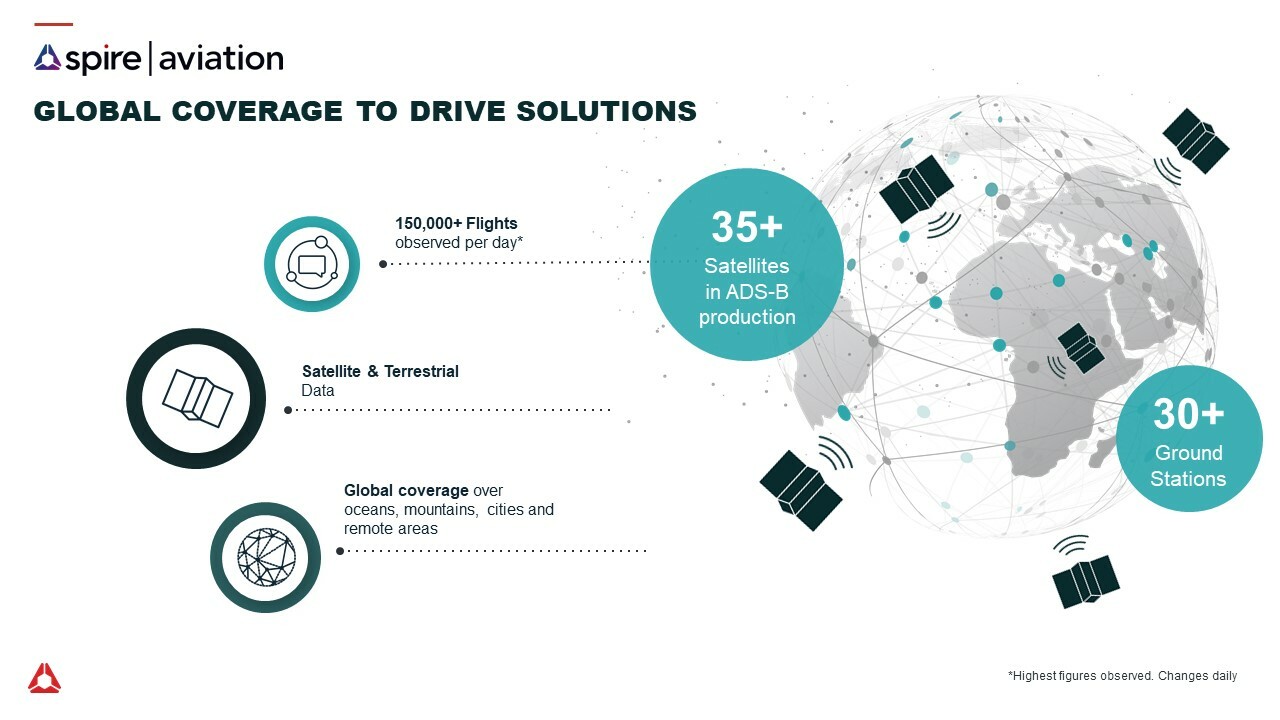
Spire Aviation has more than 35 orbiting satellites and over 30 ground stations that collect aviation information about:
- Position and Status: The first component includes vital parameters, such as longitude, latitude, altitude, speed, timestamp, vertical rate, and more.
- Aircraft and Airline Data: The second component includes information about the aircraft’s tail number, aircraft type, airline name, ICAO (International Civil Aviation Organization) address, and more.
- Flight and Airport Data: The above two components can be combined with data points from call signs, flight number, flight schedule, departure and arrival airports time, and more, to get a more complete picture.
Hypothesis 1: Air traffic data is complex and for aviation industry experts only.

Bart Adams, Founder, and CTO at xyzt.ai starts the discussion by highlighting that, today, air traffic data is easily accessible and covers global aviation activity thanks to data providers, such as Spire Aviation. This newfound accessibility opens the door for people outside of the aviation industry to start utilizing the data and ascertain how their business might benefit from this source of information.
Shay Har-Noy, General Manager at leading air traffic data provider Spire Aviation, comments that the sensors capturing the airplane’s activity are increasingly complex and aggregate with each passing day more and more information. In this sense, a part of aviation data might be too complex for most businesses outside of the industry. However, Har-Noy concludes by saying that the major components of air traffic data, such as positional and ownership data, will always be useful for many industries to generate insights and gain a competitive edge.
Philip Plantholt, Head of Strategy and Business Development at Spire Aviation, agrees on the complexity of air traffic data. He adds an interesting thought: the layer of complexity of the data equals the layer of complexity from the use case. This is an exciting aspect of air traffic data because once you get comfortable with aviation data, you can apply a simple use case applicable to a broad range of industries or you could get very precise and specific, depending on the complexity of your data and the type of analysis you aim to do. Plantholt emphasizes customer education. When providing and analyzing air traffic data, he believes it is crucial to provide people with intuitive tools and pre-studies to help them really understand the data and what it can mean to them.
Hypothesis 2: Four-engine wide-body aircraft, such as the A380 and 747, will disappear.
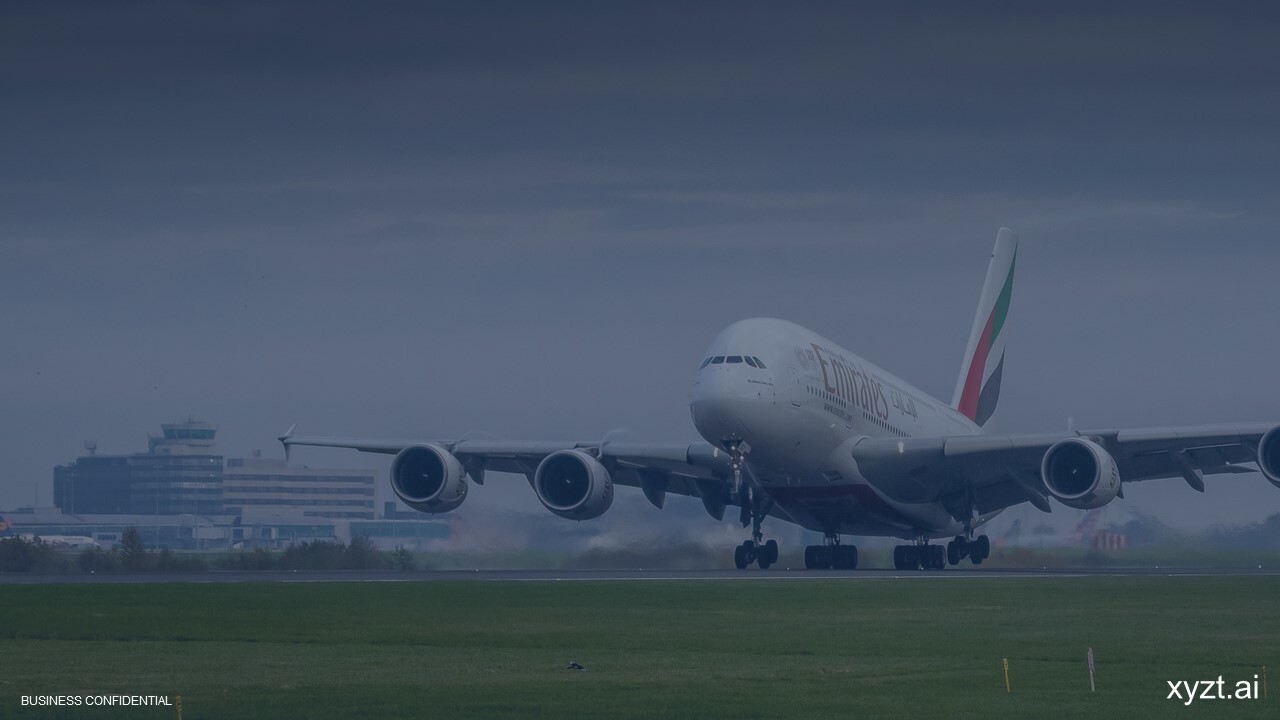
Plantholt underlines that we can not underestimate the aspect of uncertainty. At the beginning of the Covid-19 pandemic, most industry experts were certain wide-body aircraft will disappear, but how do we know for certain? What if the demand comes back? Plantholt remarks we will, most likely, see less of those types of aircraft as they also do not fare well in the environmental discussion.
Interesting Aviation Fact:
Do you know which of the A380 or the 747 will get phased out of operation sooner?
The answer is neither, they won’t be phased out until 2050.
Adams proposes to make the discussion more concrete by visualizing wide-body air traffic data, in this case: Airbus A380 and Boeing 747, in the interactive visual analytics platform xyzt.ai.
Unlock the potential in your big location data
xyzt.ai allows the user to visualize millions, and even billions, of location data points with intuitive and easy-to-use features that provide various perspectives, such as visual analytics, trend analytics, origin-destination, and distribution analytics, to explore and analyze big location data. During the webinar, Adams explains how you should proceed to start generating insights from air traffic data using the xyzt.ai platform. If you would like to see this in action, you can sign up to watch the webinar.
Adams states that the future remains uncertain, and the wide-body air traffic data clearly shows a huge decline in activity. This is especially visible when using the Split-View Analysis of the xyzt.ai platform, a tool that duplicates all views of the visual analytics page (heatmap, timeline, and data attributes). It allows the user to instantly compare and measure the air traffic activity in a certain location. In this case, the air traffic activity before and after COVID-19 to measure the pandemic’s impact on the aviation industry.
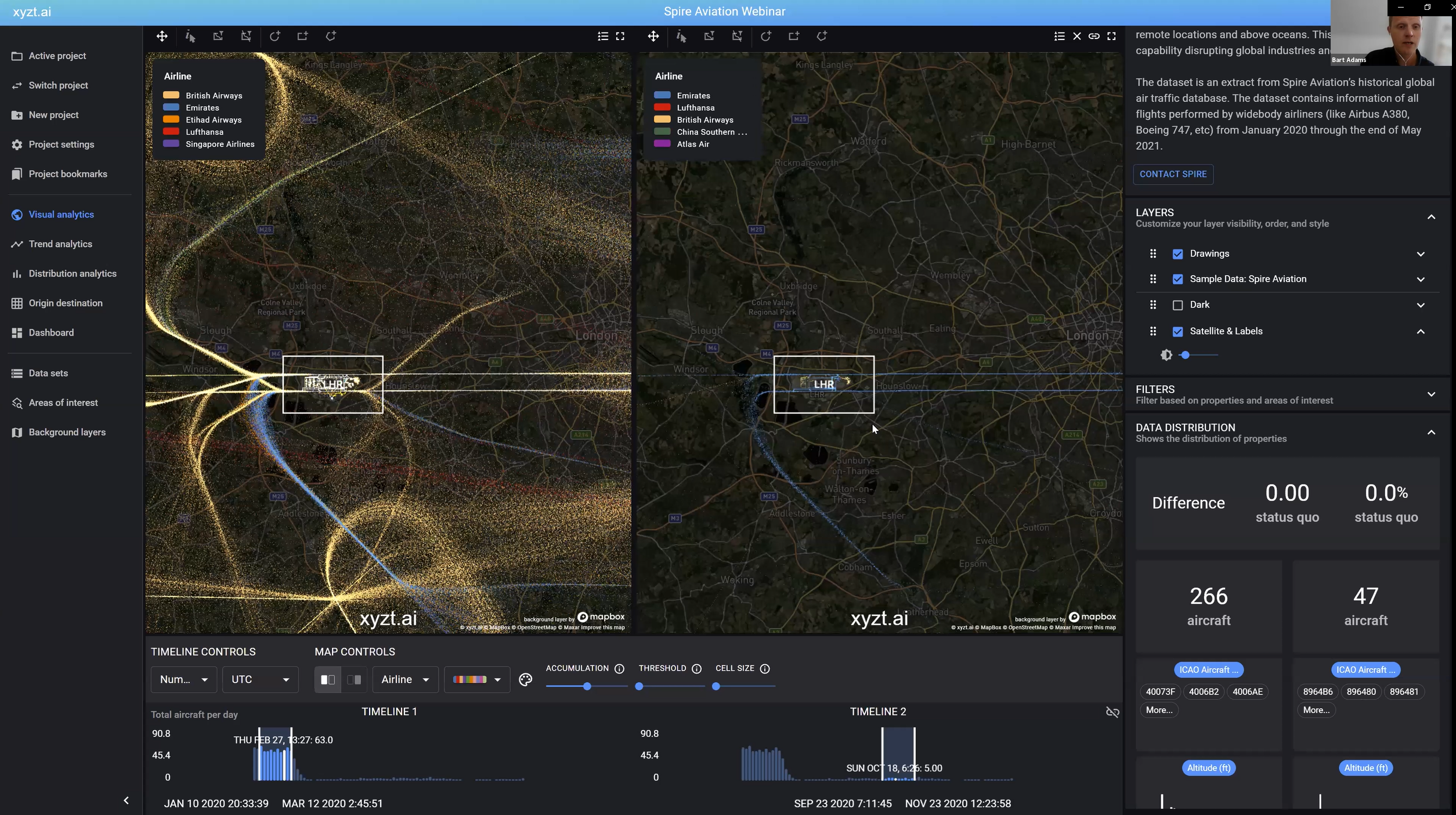
Find the demand during uncertain times
While the majority of airlines drastically reduced their aircraft in operation, some of them, such as Atlas Air, did the opposite and increased their activity. Atlas Air had the advantage of already being predominantly a cargo airline and, as a consequence of the Covid-19 pandemic, experienced a steep increase in demand. Philip Plantholt notes that it took a while for other airlines to realize this demand and adapt their strategy by changing passenger to main deck aircraft. Stories like this are very interesting because they demonstrate how trends can be found in air traffic data and how businesses can gain a competitive edge through air traffic data analysis.
“It is interesting to be able to follow air traffic data. Where are the trends, where do aircrafts fly in those times, where is the biggest demand because airlines would obviously jump on them. That is a great use case for air traffic data, to be able to find the demand in uncertain times.”
Philip Plantholt, Head of Strategy and Business Development at Spire Aviation.
Hypothesis 3: Aviation data can be used to analyze and predict economic trends

Plantholt says the pandemic has shown the enormous value of analyzing air traffic data to predict economic trends. Pre Covid-19, it was mostly flight scheduling data that was analyzed to optimize operations, but the pandemic has made it clear that such data is far from sufficient to prepare for the future. Plantholt mentions the trend of using air traffic data is here to stay and an article from Nature confirms the same. In the future, we will see more data sources being fused together to provide even wider and more accurate coverage of aviation activity.
Adams emphasizes that ADS-B air traffic data is captured in real-time and is easily available thanks to data providers like Spire Aviation. The power of this near real-time availability of valuable data should not be underestimated. This allows people to immediately spot new trends, but also – and more importantly – to act on them. Adams concludes by stating that he thinks this is a great source for companies outside of the aviation industry to predict and take advantage of global economic trends.
Har-Noy agrees that there is a high correlation between analyzing air traffic data to measure the economic activity in countries. He adds this is not only the case for passenger travel, but also for cargo. In the case of Covid-19, we have seen an inverse correlation between those two types of travel and this tells us something about how humans are behaving on a macro scale. For example, we order more stuff from the internet than we used to and this trend is unlikely to reverse.
Hypothesis 4: The Covid-19 pandemic will not leave a positive impact on climate change.

Voices are a bit mixed on this one. In a recent UN report, Secretary-General António Guterres thinks that the Covid-19 pandemic has done little to slow climate change. Har-Noy is also not sure, but he states that even though air travel has decreased, and we now have efficient communication systems for remote work, there will always be other fronts that increase and cause a further negative climate impact. For example, people don’t travel as much as before Covid-19, but cargo travel increases as we order more things online and get accustomed to receiving those orders right at our doorstep.
Plantholt agrees that the major trend of increased demand for cargo travel is unlikely to diminish. He adds that pre-Covid-19, there were three major integrators active in the air freight business: the aircraft fleets of DHL Express, UPS, and FedEx. Now, there is a new market participant, namely Amazon Air, that is gaining in popularity due to the increase in demand. This confirms the strong demand for cargo air travel and the trend of “next-day” deliveries that arrive right at your doorstep.
Hypothesis 5: As machines get smarter, the role of humans will increase.

“Every time you depend on an artificial intelligence application, there is somebody in a box behind it, pulling the trigger on the actual decision the AI recommends.”
Shay Har-Noy, General Manager at Spire Aviation.
Har-Noy says these incredibly sophisticated algorithms do a great job at synthesizing the data and making recommendations, but context and logic are the ingredients for key decision-making that only humans are capable of. Therefore, big data visualization is really an exciting topic, Har-Noy comments. It allows people to intuitively measure the context, apply logic, and make the necessary informed decisions.
Adams mentions he is unsure about this hypothesis and says it will probably go hand in hand. He comments that xyzt.ai strives to achieve what Har-Noy just mentioned. xyzt.ai has a strong focus on big data visualization, but the platform goes far beyond that. It offers the user the necessary tools and features to assist the user in an interactive and intuitive way to perform big location data analysis. Adams mentions this opens up an interesting aspect of big data visualization. When analyzing, you most likely start with a fixed set of questions you would like answered, but more often than not, while exploring the data, you’ll stumble upon unexpected patterns or occurrences that generate new insights. In other words, big data analysis holds the answers to the questions you might not yet have thought of.
Key takeaways
To conclude, we would like to provide you with 3 key takeaways from the webinar.
- Satellite-based air traffic data is not just for aviation specialists.
- Use cases range from airport, airline, and air traffic analytics to analyzing and predicting the global economy.
- Platforms exist to access, visualize and analyze historic air traffic data at scale.
Did you miss the webinar? If so, don’t worry, you can always request access to watch it.
Get Started Today!
If you have any other questions, or if need help with your data visualization and analysis needs, please contact us.
